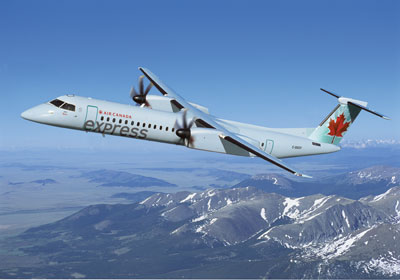
Features
Operations
Alternate Approach: The farce of full disclosure
Ten years ago, Air Canada celebrated the first anniversary of Tango, its short-lived, no-frills brand, with one-cent fares on the return portion of a round-trip ticket.
March 22, 2012 By David Carr
Ten years ago, Air Canada celebrated the first anniversary of Tango, its short-lived, no-frills brand, with one-cent fares on the return portion of a round-trip ticket. Unfortunately, the penny promotion was weighed down by user fees and other charges, leaving Robert Milton, Air Canada’s CEO to complain to this magazine that air transport was the only consumer business blocked from giving free samples.
 |
|
| Added charges are an immovable lump that distorts the price an airline charges to deliver a product. PHOTO: Bombardier |
Ever since, Canadian air transport correctly shifted course to a user pay system, which included local management of airports and the groundbreaking sale of NAV CANADA, the air navigation system (see, “Controlling their destiny,” pg. 43). Airlines have been accused of deception – or worse – for failing to roll third-party charges and taxes in advertised fares, either in print or online.
In the murky world of airline pricing, the current half-loaf approach to fare advertising is frustrating. How murky are the waters right now? For example, planning a trip to England this spring on Air Transat, the added charges are slightly higher or lower than the advertised fare, depending on the day of departure.
But consumer advocates are confusing frustration with transparency. In a Globe and Mail column, financial advisor Preet Banerjee likens the current airline pricing model to buying gasoline (another commodity larded with layers of taxation. For example, if the price per litre were 50 per cent higher at the cash register, than what is posted on roadside signage? It is flawed logic. Airlines do not wait until after the transaction to bulk up the ticket with additional charges. It’s more like the add-on of sales taxes at the point of purchase, except on a more eye-popping scale.
Four years after the government first announced it would require airlines to advertise the full price of a ticket, it is unlikely that there is a consumer who doesn’t see a posted airfare and automatically multiply by two (or more if the fare is deeply discounted). Steve Fletcher, minister of state for transport, has dusted off the “all-in-one” airfare advertising pledge, declaring that the government will enhance “consumer protection while promoting fair competition” by ensuring “truth in [airline] pricing and advertising” will occur by the end of 2012, when Canadian airlines will be required to advertise the full prices of airfares.
But putting to one side the richness of an elected politician championing truth in advertising, it is not clear how rolling every tax or user fee into the advertised fare makes airline pricing more transparent. It will certainly not lower fares.
The portion of the fare airlines have traditionally resisted putting in the shop window includes NAV CANADA and airport improvement fees, the air traveller security charge, taxes in addition to the HST and GST, and charges levied by foreign governments on international flights. These charges can gobble up between 30 and 70 per cent of the cost of a ticket depending on the route and point of origin according to a study conducted by York University’s Schulich School of Business.
Whereas airline pricing is fluid depending on the hour, day and time of year travelled, added charges are an immovable lump that distorts the price an airline charges to deliver a product.
Where the government has a case, is the addition of fuel surcharges, which a friend once likened to “chipping in for the gas.”
Europe and the U.S. have already moved to regulate all-in pricing, and Canadian airlines have already jumped ahead of the government’s timetable. Will this be enough to satisfy government regulators, or will the Canadian Transport Agency (CTA) go deeper into the weeds by insisting, among other things, that an ancillary service such as baggage check-in fees be included in the posted fare?
The solution was as simple as airlines being more upfront by advertising the full fare alongside a highly visible box that separates charges the industry has no control over. The question is, why now? If the Harper government is sincere in protecting air travellers and promoting competition, it is clearly working from the bottom of the pile.
Instead of grandstanding, the government should focus on making Canadian air transport more competitive by reducing airport rents and reversing the drain of an estimated 2.2 million Canadians who travel to U.S. border airports every year to take advantage of cheaper flights. But it won’t, because it doesn’t cost anything to kick the airline industry yet again.
David Carr is a Wings writer and columnist.